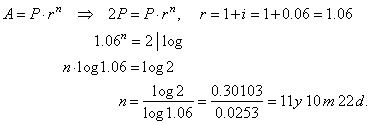|
|
|
ALGEBRA
- solved problems
|
|
|
|
|
|
|
|
|
| Interest
calculations |
| Simple interest
|
|
|
| 111. |
Somebody deposits $20,000 into a savings account
where the rate of interest is 4.8% annually.
|
|
|
How much money in interest will earn after nine months?
|
|
An amount of money deposited into a bank for a given period of
time brings to the depositor a profit called interest.
|
| The
amount of
interest (I
) the bank pays you, depends on the
interest rate (
i % ),
the amount of money deposited, denoted as principal P
also called original balance (or
initial investment), and the period of
time n
the money is deposited, |
|
since P
: 1 = I : (i · n)
then, |
 |
|
|
|
|
|
Solution:
Given,
P
= $20000 ,
p%
= 4.8% and n
= 9
months,
I
=
?
|

|
|
|
| 112. |
A bank lends a company money for the six months period at
a rate of 8% annually.
|
|
|
How much was lent if the company should pay $12,000 of interest?
|
|
Solution:
Given,
I
= $12000 ,
p%
= 8% and n
= 6 months,
P
=
?
|

|
|
|
| 113. |
At what an interest rate was borrowed
$75,000 for one year if $3,000 to interest is charged?
|
|
|
Solution:
Given,
P
= $75000 ,
I
= $3000
and n
= 1 year,
i
=
?
|

|
|
|
| 114. |
For what period of time should be deposited
$200,000 at a 6% interest rate to earn $6,000
|
|
|
of interest?
|
|
Solution:
Given,
P
=
$200,000
, p%
= 6%
and I
= $6,000,
n
=
?
|

|
|
|
| Compound interest |
|
| 115. |
If $10,000 is invested for
five years at 6% of the interest rate, find the accumulated or
final value and
|
|
| total interest earned at the end of the period
under both, simple and compound interest. |
| In compound interest calculations,
the interest earned in each period is added at the end of a
period to the principal of the previous period, to become the
principal for the next period. |
| The compounding periods can be yearly, semiannually, quarterly,
or the interest can be compounded more frequently even continuously. |
| If
P
is the principal or initial value of investment, A
is the accumulated amount or final value of investment and the compound interest
rate is i % |
|
then,
A = P · r
n,
where r
= 1 + i,
and where |
|
|
|
Solution:
Given,
P
= $10,000, p%
= 6%
and
n =
5 years, A and
I
=?
|
| a)
Under simple interest,
the total interest earned in five years period is |
|
I = i% · P · n =>
I = 6/100
· 10000 · 5 = $3000, |
| the accumulated value after five years period is |
|
A
= P + I = P (1 + i n) =>
A
= 10000 · (1 + 6/100 · 5) = 10000
· 1.3 = $13000, |
| so
that I
= A -
P
= 13000
-
10000 = $3000. |
|
b) Under compound interest,
the accumulated value after five years period is |
|
A
= P(1 + i%)n
=> A
= 10000 · (1 + 0.06)5
= 10000 · 1.338225 = $13382.25 |
| therefore, the total interest earned in five years period is |
|
I
= A -
P
= 13382.25
-
10000 =
$3382.25. |
| So,
the interest compounding (or interest earned on interest) brings
the extra $382.25 in
comparison with the simple interest. |
|
| 116. |
After how many years will
deposit double at an interest rate of 6%.
|
|
|
Solution: |
 |
|
|
|
 |
|
|
| 117. |
At what annual interest
has to be deposited $5,000 for four years to grow to $8,000.
|
|
|
Solution: |
 |
|
|
 |
|
|
|
|
|
|
|
|
|
|
|
|
|
|
|
|
| Solved
problems contents |
|
 |
|
| Copyright
© 2004 - 2020, Nabla Ltd. All rights reserved. |